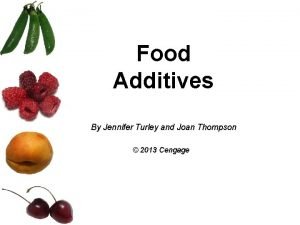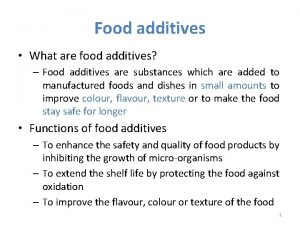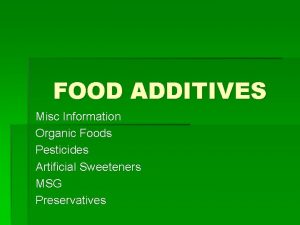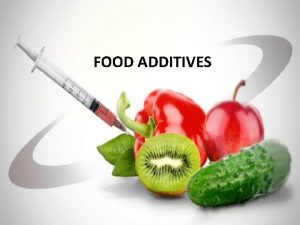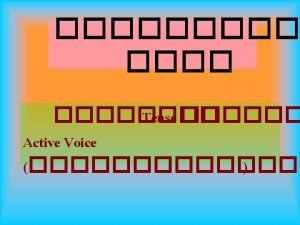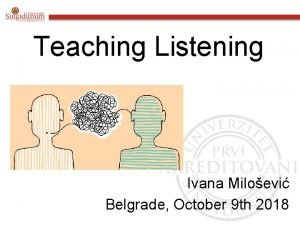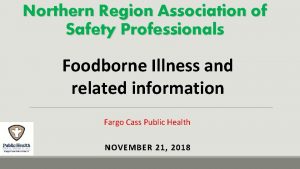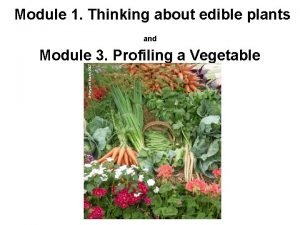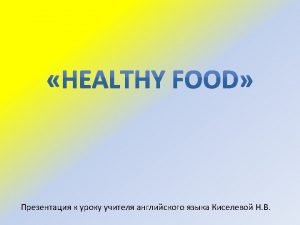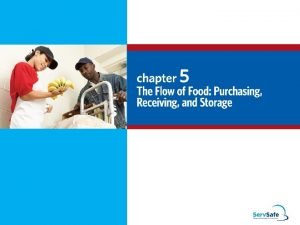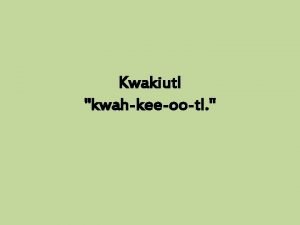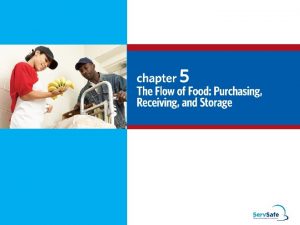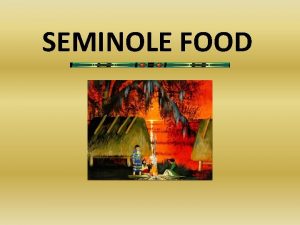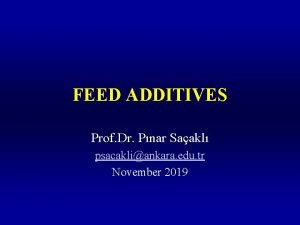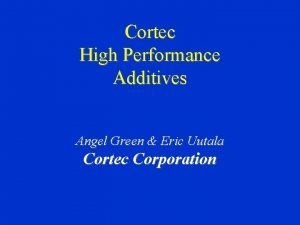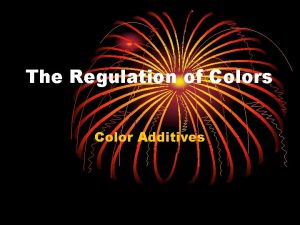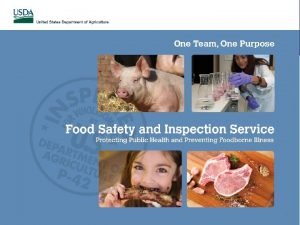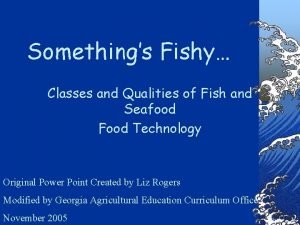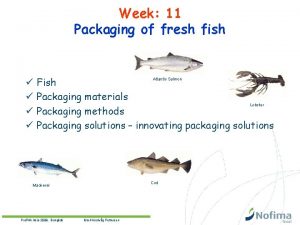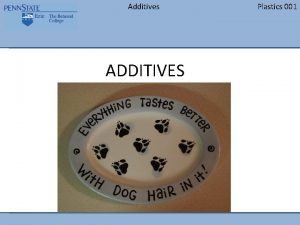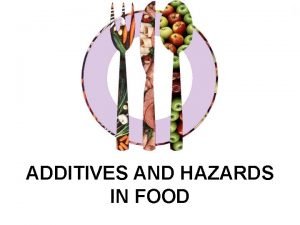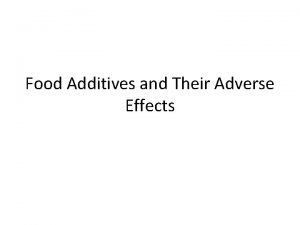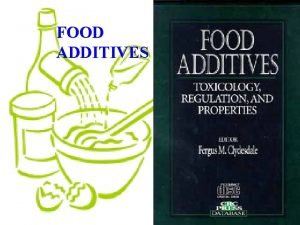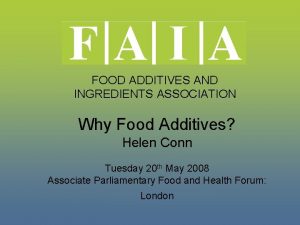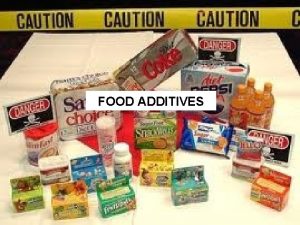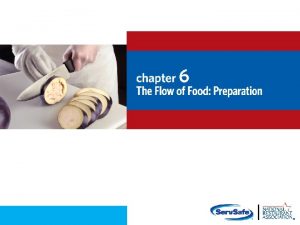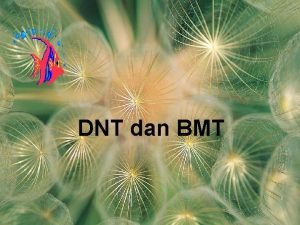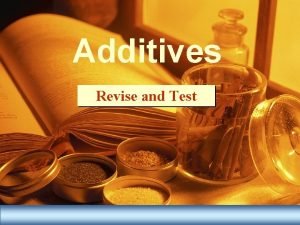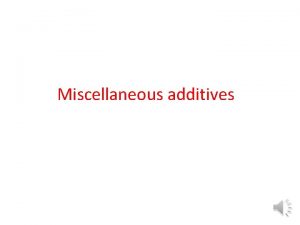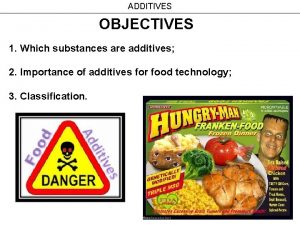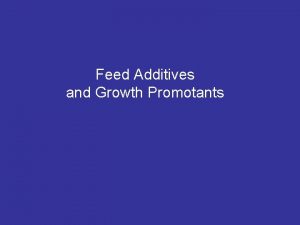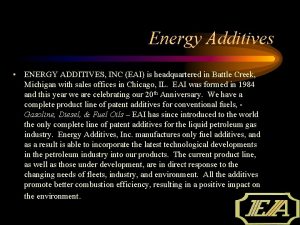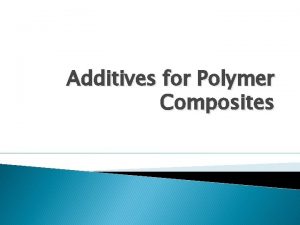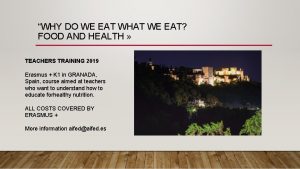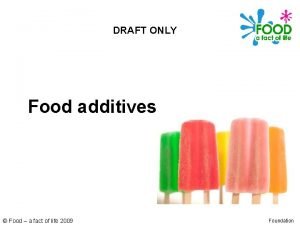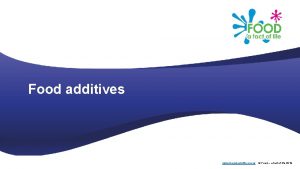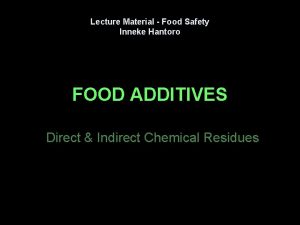Food Additives Additives What do we eat Fresh

































- Slides: 33

Food Additives

Additives [ What do we eat? [ Fresh food versus processed food. [ Changing patterns of food consumption. [ Longer storage and processing [ Need to maintain food quality

What are additives? [ Substances added to food that are not naturally present [ Not nutritive [ Original aim usually preservation [ Later to enhance food appearance [ and enhance food quality

Types of Additives and their Functions

Food Regulation [ US GRAS system [ Generally Recognised As Safe [ Introduced in 1958 to approve established food ingredients [ New additives must be approved by FDA [ Delaney Clause to prohibit any substance known to cause cancer

Additive Testing [ Relies on animal tests to NOEL [ No Observable Effect Level = highest dose of additive with no effect on animal [ Reduced by a factor of 100 to give safety margin for humans

E number system [ European system for approved food additives [ E classification shows the additive is safe for use in food [ Internationally recognised and also used in other countries

E numbers

Earliest Additives [ Preservatives [ Sodium Chloride, Salt [ Used for 10, 000 years to preserve meat products [ Salt reduces water availability for bacteria to grow [ Crude salt is contaminated with sodium nitrate [ Additional use of smoke

Traditional Additives [ Used for thousands of year Y Salt and saltpetre Y Smoke Y Honey Y Vinegar Y Herbs & Spices Y Natural food colourings Y Calcium carbonate

E 250 Sodium Nitrite [ Sodium nitrate contaminant of crude salt [ Found to cause pinkish colour in meat [ Sodium nitrite more effective [ On high temp cooking can be converted to carcinogenic compounds nitrosoamines. [ Potent inhibitor of anaerobic metabolism [ Prevents growth of major food pathogen [ Clostridium botulinum

Clostridium botulinum [ Common soil bacteria [ Anaerobe can only grow well when no oxygen present [ Spores heat resistant to 120°C for 3 mins [ Bacteria produces protein toxin [ 1µg fatal, respiratory paralysis and cardiac failure

Meat colour [ Fresh meat ~ purplish red Y Exposed meat, bright red oxymyoglobin Y Later turns to metmyoglobin, gray or brown [ Nitrite reacts to form nitrosomyoglobin Y After Y cooking – nitrosohaemochrome pinkish red in colour

Cured meat [ Pickled in salts, Y Salt, sodium nitrite, ascorbic acid, sugar Y Meat submerged in strong solution Y Or injected by machines with multiple needles Y 10 days at 4°C

Smoking [ Wood fire, produces anti bacterial compounds [ Provides surface coating and protection [ Colour and flavour [ Hams, heated to 60°C Y Not sterile, must be refrigerated, Y But can be eaten raw [ Bacon, only heated to 52°C Y Cannot be eaten raw

Sausages [ Ground meat, low quality off-cuts Y Natural casing, eg. sheep intestine Y Stuffed + spices, salt, sugar, ice Y Sodium nitrite to inhibit Clostridium botulinum

Frankfurters, hot dogs [ Meat comminuted Y Ground very finely to form meat emulsion Y 30% fat, 10% water Y stuffed in cellophane casings to form links Y smoked or cooked to 75°C Y De-skinned, passed through hot water and skins peeled off by machine.

Spoilage [ Become slimy Y Surface [ Turn growth of yeasts and bacteria green Y lactobacter releasing hydrogen peroxide Y Reacts with nitrosohaemochrome Y oxidises it to a green colour

More Preservatives [ E 200 Sorbic Acid, soft drinks, yoghourt. [ E 210 Benzoic acid, jams, creams [ E 220 Sulphites, SO 2 wine, vegetables, drinks Diphenyl, fruit Nisin, cheese Hexamine Fish Propionic acid Bread [ E 230 [ E 234 [ E 239 [ E 280

Antioxidants [ Chemical preservation [ Most important for fats Y E 300 Ascorbic acid (vitamin C) Y E 306 Tocopherol (Vitamin E) Y E 320 BHA meat products, dairy products Y E 321 BHT meat products, dairy products

Flavour [ Artificial Sweeteners Y sucrose Y cyclamate Y saccharin Y aspartame Y sucralose Y alitame Y thaumatin 1 30 300 180 600 2000 2500

Artificial Flavours [ Mimics of natural flavours using complex mixes of pure chemicals [ Synthetic banana flavour amyl acetate Y amyl butartae Y ethyl butartae Y isoamyl acetate Y isoamyl butarate Y linalool Y + 15 others in lesser quantities Y

Flavour enhancer [ E 621 monosodium glutamate [ amino acid - glutamine

19 th century [ Increased urbanisation & food processing Y Adulteration Y Use of cheap substitutes Y Colour & flavour enhancers [ Sometimes Y 1857 dangerous survey of confectionary found colours: V Lead chromate V Mercuric sulphide V Copper arsenite

Food Colours [ Preserved Vegetables Y Chlorophyll, green pigment in plants is unstable Y Green colour from copper salts due to cooking under acid conditions in copper pans

Confectionary [ Colouring to enhance consumer appeal Y Natural Y Inorganic Y Synthetic

Natural Colours [ Caramel, brown from burnt sugar, Y most widely used colour, Y not always classified as an additive [ Carotenoids, orange/yellows [ Anthocyanins, reds & blues [ Betalaines, red/purple [ Turmeric, root of turmeric plant, yellow [ Cochineal, insects from cactus, scarlet

Synthetic Colours [ Yellow Tartrazine Y Sunset yellow [ Red 2 G Y Ponceau 4 R Y Amaranth E 102 E 110 E 128 E 124 E 123 [ Blue Brilliant Blue FCF E 133 [ Green Food Green S [ Brown Chocolate Brown E 155 E 142

Dye problem [ Many organic chemicals with bright colours found to be carcinogenic [ Flat shape allows them to interfere with DNA helix [ Usually found by effects on people making them not those eating them [ e. g. Butter yellow [ Not allowed to be used in foods

Bread [ Flour whitening Y calcium [ Anti carbonate caking agents Y ammonium [ Dough citrate enhancers Y stearate [ Leavening Y baking agents powder

Emulsifiers [ Stabilise mixtures of food components [ Oil and water [ Natural emulsifier - E 322 lecithin [ Synthetic YE 471 Glyceryl monostearate Y E 442 Ammonium phosphatide Y E 435 polysorbate

Thickeners [ Non-starch polysaccharides [ Bind water to form gels [ Algal origin Y Alginates, agar, carrageenans [ Plant Y origin Guar gum, Locust Bean gum [ Modified Y methyl cellulose [ Bacterial Y celluloses, origin Xanthan gum

Is It Safe [ Better than the alternative [ Food degradation by biological or chemical action - very unsafe!
 Examples of intentional food additives
Examples of intentional food additives Natural and artificial food additives
Natural and artificial food additives Food additives examples
Food additives examples Food technology revision
Food technology revision Msg pesticide
Msg pesticide Food additives definition
Food additives definition I would rather eat potatoes that eat rice
I would rather eat potatoes that eat rice They eat or eats
They eat or eats People buy me to eat but never eat me what am i
People buy me to eat but never eat me what am i Halton fresh food box
Halton fresh food box Unit 2 food food food
Unit 2 food food food Food chain food chain food chain
Food chain food chain food chain Ready to eat tcs food must be date marked
Ready to eat tcs food must be date marked Big 6 illnesses
Big 6 illnesses Leaves that we eat
Leaves that we eat What is your favorite food جواب
What is your favorite food جواب What crops did the iroquois grow
What crops did the iroquois grow Ready to eat tcs food must be date marked
Ready to eat tcs food must be date marked How will eat food
How will eat food Kwakiutl houses
Kwakiutl houses Purchasing images
Purchasing images What did native americans eat
What did native americans eat Feed additives classification
Feed additives classification The monophasic liquid are prepared with which solvent
The monophasic liquid are prepared with which solvent High performance additives
High performance additives Polymer additives definition
Polymer additives definition Color additives amendment
Color additives amendment Incidental additives examples
Incidental additives examples The flesh is firm and elastic
The flesh is firm and elastic Fresh lemonade physical or chemical change
Fresh lemonade physical or chemical change Febrile non hemolytic transfusion reaction
Febrile non hemolytic transfusion reaction Generates fresh produce and other farm products
Generates fresh produce and other farm products Fresh fish packaging solutions
Fresh fish packaging solutions Fresh water density
Fresh water density
